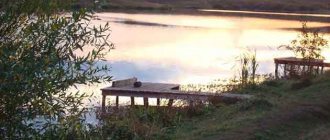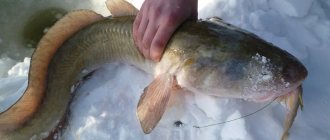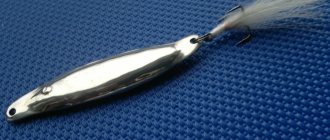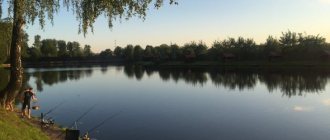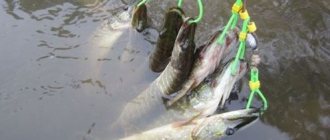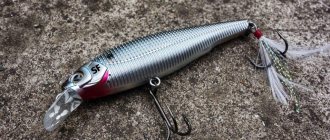A hole in the river is a very catchy place - proven by practice. It is in it that the toothy mouth of a predator waits for its prey - your bait; peaceful fish also spend a lot of time in it, which may also be interested in your bait. Therefore, you just need to know how to find holes on the river. A hole in the river is a very catchy place - proven by practice. It is in it that the toothy mouth of a predator waits for its prey - your bait; peaceful fish also spend a lot of time in it, which may also be interested in your bait. Therefore, you simply need to know how to find holes on the river - we will tell you about this today. But let's start with a definition so that it is clear what to look for.
How to find an edge or hole?
Very often you can observe a picture when one fisherman has a bite after a bite, and there are several fishermen sitting around who have no bite at all.
It's a shame to the point of tears. And the fishermen, one after another, are trying to find out what kind of bait he’s biting on. After long negotiations, it turns out that he is hooked on the same thing that they are hooked on. And then the fishermen can’t stand it and unanimously say that he has a good place. To be frank, that's true. For fishing to be effective, you need to be able to find a fishing spot. Fish in reservoirs do not live in places that are not interesting to them, and interesting places for fish are places where there is something to eat. She swims to these places constantly, throughout her life, although she can rest and spend the night in completely different places.
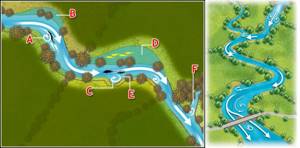
The favorite places for fish are holes and edges, as well as the muddy bottom of the reservoir, where the highest concentration of food is. Therefore, the first and main task of the fisherman is to find such places.
How can this be done?
By using a feeder, you can easily attract fish if there is one in the immediate vicinity or this is a place frequently visited by fish. In this case, fishing will take place. If fish rarely visit this place, then it will be difficult to attract it, and fishing will not be interesting.
Many fishermen identify promising places visually. They can be identified by characteristic turbulence on the surface of the water, indicating the boundaries of riffles and holes. If earlier this gave good results, then in our time this is no longer enough. Most likely, this is due to the fact that there are fewer fish and at the same time, they have become smarter. Based on this, when going fishing, you should arm yourself with the basic rule: first of all, you need to study the bottom topography and only then start baiting and fishing.
Why look for an edge on the river?
Despite the reluctance to find an edge, often caused by ordinary laziness and reluctance to engage in tedious preparatory operations, the presence of a catchable edge on large rivers often has a noticeable effect on the effectiveness of fishing. This happened on a recent fishing trip with my son. We took with us short homemade feeders made from spinning rods and intended, in general, for fishing on ponds and small rivers. The casting range of these donk feeders was quite enough to reach all the catchable points on crucian carp ponds, where the fish adheres to the shoreline, and the same catchable points on small rivers. Usually these were casts of 20-40 meters .
Arriving at the rather large Vetluga River, we were faced with a peculiarity of the river, where it was impossible to reach from one shallow bank with our homemade feeders to the pit, and from another steep, steep bank to the drop from the pit to the shallow water. Both here and there, in these intermediate areas between the hole and the border with shallow water, only the medium-sized white-eyed owl pecked. Therefore, my son did not come across any relatively large fish at all. Of course, we were unlucky and, in fact, there was almost no bream on our visit. But nevertheless, on my branded feeder with a length of 3.9 m and with test indicators of 60-90-120, from time to time I came across bream, I took a bream weighing one and a half kilograms and a dowry. Another cat broke loose, I believe because of the small hooks my feeder was equipped with. Still, the size of the hooks on Vetluga should clearly be larger than on a small city river (report on our fishing on Vetluga).
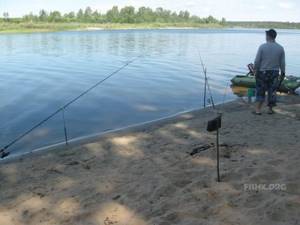
What is the reason for this difference?
The difference in the type and size of the prey was that the branded feeder, which I almost abandoned when fishing mainly on a small river, allowed me to throw the feeder and hooks with bait over a distance of more than 50 meters . And this was quite enough to throw us up to the slope onto the pit , which was located under our steep bank. All casts into the pit itself brought only a medium-sized white-eyed sop, although it seemed that all the large fish should be in the pit. But this is a common misconception.
The edges and slopes of the pit are the most inhabited horizons, where mollusks and vegetation settle. And this is food for many fish, including bream. The upper part of the edge is especially rich in various forms of life. The thermocline is often located here - the boundary between cold and warm layers of water. Fish for the most part prefer warm water, especially if they are representatives of the carp family. Only in the summer heat, when the water warms up to the state of fresh milk, do the fish go to deeper places, where the water is cooler and saturated with oxygen.
Search for an edge
If the fisherman has a large stretch of shore at his disposal, then there will be no particular problems with finding a promising place. Unfortunately, this is an ideal option that cannot be realized in our time. The whole point is that there are fewer and fewer fish, and there are more and more fishermen, and all promising places, as a rule, are occupied. But this does not mean that even a place that is not promising, at first glance, cannot become so. If a fisherman knows how to “feel” the bottom topography, then this problem can be quickly solved, especially since he will not fish blindly.
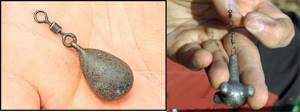
To find promising places, fishermen use a sinker and slowly move it along the bottom of the reservoir. To do this, take a “drop” type load and cast it with a fishing rod as far as possible, after which you should wait until the load sinks to the bottom. After this, you can rewind, and very slowly. Moving along the bottom, the load begins to “transmit” all the information about the nature of the bottom; the main thing is to listen carefully and watch the movement of the rod tip. Braided fishing line, which has a low specific stretch, conveys this information very well.
Having done several similar trainings, you can easily determine the boundaries of the pit, find the edge, find out whether the bottom is muddy or clean, as well as the presence of stone placers or shell rocks at the bottom.

After studying the bottom topography and identifying a promising location, you can begin to feed the fish. To do this, you need to make a mark on the fishing line, which will indicate the exact location of the bait site. At the same time, it will be possible to make all other casts to the same place. This technique is suitable for reservoirs with standing water or weak currents.
To find a promising place, you can use the “jig” fishing technique. To do this, you can take a “jig” bait and “walk” with it along the bottom of the reservoir. Many fishermen also take spinning rods with them when fishing, which can be used purely for their intended purpose or used as a rod for bottom fishing. Not every fisherman can afford a feeder rod, so they use spinning rods, and use bells or other devices as bite alarms. Such generalist fishermen, in the absence of a bite, can easily switch to catching a predator, so they always have various baits in their arsenal, including for “jigging” fishing. Studying the bottom topography is not a problem for such fishermen.
Having decided on the bottom, baiting the fish begins. To begin with, you should make several casts without a hook, but only for the purpose of delivering food to the biting place. To do this, fishermen use special “Rocket” type feeders to deliver food to the fishing spot: when it hits the water, it opens and throws out its contents. Usually up to five such bait casts are made to begin with.
For this purpose, some fishermen use radio-controlled boat models specially designed for this purpose. And why not, if for the sake of fishing, individual fans of this business are able to give everything they have. They spend most of their money on fishing equipment, not counting the car. Nowadays, such concepts as an avid fisherman and an expensive “jeep” are inseparable.
Studying the bottom topography is especially important when you have to fish in an unfamiliar body of water and for the first time. Some fishermen prefer their “native” body of water, where they fish throughout their lives, and know it like the back of their hand. And others prefer to travel all over the country in search of something special. As a rule, they have to look for promising places every time, studying the topography of the bottom of the reservoir.

Yes, to be honest, this takes a lot of time, but you need to know that without doing this, you can be left without a bite, and therefore without a catch, although for many amateur fishermen this is not the main thing: the main thing is to be in nature, see how water flows, forget about your everyday everyday problems and gain strength and energy to take on solving these very problems with renewed vigor.
Standard method
Measuring the depth with a feeder is best done with a working rod, the one that will be used for fishing. Simply, instead of equipment, a weight is attached to the end of the fishing line, approximately the same weight as the feeder will be used later in the fishing process. Ordinary lead bottom weights or special marker weights are used. You can attach such a load to the main line using a regular noose in a loop. Read more about marker weights.
Bottom sounding is far from a simple undertaking. There are many little things in it that depend on the characteristics of the reservoir - depth, strength of current, bottom topography. The search and selection of a point is also influenced by the type of fish the angler is hunting. There is no single measurement algorithm - it all depends on the goals of the fisherman and local conditions. Each feeder develops over time his own specific actions when searching for a point. For beginners, it is recommended to practice what is written below on a well-known body of water in order to understand the nuances in terms of tactile sensations from the rod in the hand.
So, we take measurements with a working rod. Most amateurs have one. Advanced fishermen and athletes often collect special separate tackle just for measuring, and the working length of the tackle to the point after determining the composition and structure of the bottom is transferred to the working tackle using pegs (more on this later). The goal of an ordinary angler is to clip the line into the reel in such a position that when casting, the feeder always falls into the same place found during the measurement - this is a critically important aspect of feeder fishing in general. Until this moment, you will have to make a lot of casts and clips, the ultimate goal of which is to find the desired fishing point (or two).
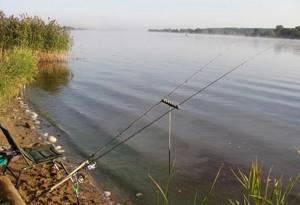
While examining the bottom, you need to build up in your head a rough understanding of the bottom topography in the fishing area. The location of the point imposes its own nuances on tactics and equipment. As in any other fishing method, first of all we are interested in any deviations in the relief - edges, slopes, local pits, changes in depth. In reservoirs with complex terrain (rivers, reservoirs), the first thing of interest is the edges and tables (flat areas, terraces) underneath them.
It is more difficult to search on a uniform terrain - you need to calculate small changes in depth (canals, ponds). There are many moments. The purpose of this article is to provide a framework from which to build. The simplest thing is to determine the edge when fishing with a feeder, for example, on a river when searching for bream. Let's focus on this. The feeding spot and the fishing point should be located a little further from the lower edge of the dump, on a flat area after it (terrace). Finding such a place is the main task of the feeder who arrives at the reservoir.
So, instead of working installation, we hang a weight, regular or special marker, on the feeder. The weight is selected depending on the conditions of the reservoir:
- 15-30 g on small ponds and canals with a muddy bottom (heavy loads will simply fall into the bottom sediments);
- 30-60 g. – ordinary rivers, lakes and ponds, medium flow and hard bottom;
- 90 g and more - large rivers with strong currents, long distances, fishing with Heavy and Extra Heavy gear.
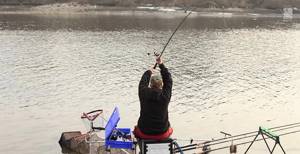
Dragging
First, we cast to the maximum possible distance. After immersing the load, we place the feeder rod with the tip down, to the side, and slowly rotate the reel and pull it along the bottom. Depending on the structure of the bottom, tactile sensations and behavior of the quivertype occur differently.
- Soft muddy bottom – constant light load;
- Hard, flat bottom (clay) – the load is less, the sinker slides;
- Shell - small taps on the hand;
- Stone - stronger, louder twitching.
- Getting stuck means getting caught in snags or grass, but more often – the sinker comes out under the edge. This is the signal we are looking for. During repeated castings it will become clear whether this is actually so.
- Sharp acceleration, easier movement of the load - on the contrary, a sharp increase in depth, the sinker jumps down the step.
Dragging the sinker along the bottom is just the initial stage. The goal is to roughly understand the structure of the bottom and find out disturbances in the relief. The method of dragging a sinker along the bottom cannot accurately paint the picture. This is just reconnaissance. Therefore, after the initial rough determination that there seems to be something interesting over there, we move on to carefully breaking through a specific segment. To do this, the method of determining the depth by dropping a sinker on a quick count is used.

Tables under dumps
Consecutive casts for a quick score
Dragging and counting work together - this is the only way to survey the bottom topography and measure the depth with a feeder at the same time. For example, during pulling, we suspect that we have found a suspected edge in some place (the sinker gets stuck and is released only after some effort - the so-called pulling). Next, you need to make sure of this and study the area more thoroughly. Checking the bottom of a reservoir for feeder fishing using the quick count method is the simplest and most accurate option.
The essence of the method is to measure the time the weight falls after the splash with a count. We count quickly so that even a slight change in depth can be determined. Naturally, for each operation the counting frequency is needed to be the same - to eliminate the possibility of error. Over time, this skill is trained. Comparison of counting indicators at different distances gives an idea of the change in depths. Accordingly, the more you count, the deeper it goes, and vice versa. How to break through the bottom with a feeder?
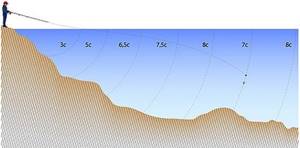
Let’s say that while dragging, there is a place where the marker weight gets stuck, and it needs to be pulled. This is a clear suspicion on the edge. The sinker usually gets stuck in the lower part of the edge, as it rests against the fall, and the main cord rests on the ridge. We find the point again. We stretch until the load gets stuck.
Important point! Further activities are specifically related to the fishing point and determining the final clipping position. Therefore, during all manipulations after casting, we keep the feeder rod in almost the same position in which we will fish (so as not to make a mistake by a meter or two due to the difference in the location of the gear).
- So the load is stuck. We assume that he is on the lower edge. Under the edge we are interested in a flat area, completely horizontal or with a slight drop (5-10 cm per meter). This is a promising place for catching bream, ide, roach and any other white fish in the river. We place the feeder in the correct position and clip the cord. We cast using a clip with a count. You can check again - stretch the load a little, if it gets stuck again, it means everything was done correctly. The count is the relative depth at this point (presumably under the edge). Everyone has their own account, so exactly how many meters of depth is not so important. The very fact of the difference is important.
- Don't forget - the feeder is in working position. We remove the clip and unwind the fishing line from the clutch, for example, a meter or up to the first ring. Let's clip again. Thus, we increased the range by this distance. We assume that when casting, the load will fall a meter further, not reaching the edge. And if there is a level table, the score will be about the same.
- We unwind the line and cast, counting. If the score is the same, the desired terrace has been found. You can measure even further, for the sake of interest and confirmation of this. It is also performed through clipping and counting. If the depth (count) continues to increase greatly, we measure further until we find the table. The ideal place is a flat terrace under the slope, the point for final clipping is at the beginning of the table. If the edge is too steep, then it is better to choose a point a little further from the rise to make it easier to drag the feeder during subsequent fishing. We strongly recommend that beginners thoroughly familiarize themselves with the training videos from recognized feeder masters Fadeev and Kolganov, below and at the end of the article. Correct bottom measurement and choice of point is the entrance gate to the fascinating world of feeder fishing.
Video - Fadeev’s detailed instructions on searching for edges on large rivers.
A complex approach
This is just one specific measurement case. Namely, the location of the table under the edge. There are much more conditions for fishing with a feeder and possible variations in the reservoir. For example, on reservoirs with a uniform topography it is generally difficult to determine anything. Only careful measuring of each meter will help, dragging it in order to determine the structure of the bottom. For example, finding a strip of shell among sand or silt. Finding the edge with a feeder can be easy if there are quite significant differences, but if there are no such differences, the process becomes more complicated. For example, where to form a fishing point for crucian carp in a pond with a flat bottom and a depth of 1.5 meters without drops?
Here you need to look for anomalies that are absolutely invisible at first glance - a change in the strength of the depth difference (for example, not 10 cm per meter, but 5), or bushes of some kind of vegetation, different bottom soils (light or heavy silt, clay, shells).
In addition to measuring one direction, it is important to measure the bottom topography to the left and to the right, fan-wise. This is the only way to draw a general picture of the point in your head. Maybe it is there, and not right in front of you, that the treasured folds of the bottom topography will be found. You can transfer measurements to paper by sketching diagrams with depths and distances. What can result from failure to comply with this - in Kolganov’s video:
You can use pegs. These are just two sticks on the shore, located at a fixed distance (3,4,5 meters). With their help, the working length of the clipped descent of the tackle is measured. This gadget will come in handy in case of a break and you need to restore the working length. Or to transfer the required distance to another feeder. Athletes usually use special line marker pegs, but they are very easy to make with your own hands. Two pokes and a rope between them - and there is a lot of benefit. To take the measurement, the feeder trough clings to one of the pegs. Then the working cord is wound around the pins, up to the clip. The number of revolutions is multiplied by the distance between the stakes - we get the working footage to the point.
In addition to pulling up and lowering the sinker on a count, you can use other methods - jig tapping, wireless echo sounders, tackle with a marker float. It doesn’t matter how exactly, the main thing is to find the fishing point and clip the distance to it on the gear. You can use various measuring methods, combining them with each other.
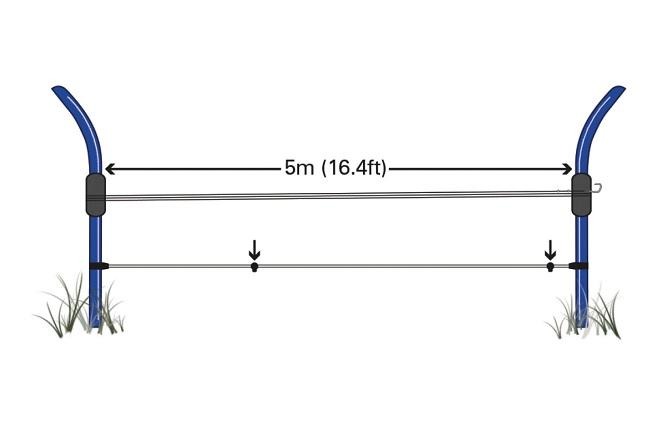
Pegs
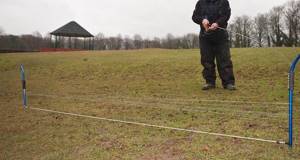
Maintaining distance on pegs
What is an "edge"
Those who are not familiar with the terminology and have not encountered the concept of a river edge should figure out what it is.
In places where fast currents or strong turbulences of the flow wash away soil from the bottom, the depth of the river changes. Sometimes the bottom goes down slowly, almost imperceptibly, sometimes it ends abruptly. The slope is called a slope, the flat parts are called a table, and the places where the breaks are called edges. Some call the entire slope the edges, but this is incorrect.
Eyebrows are distinguished according to the following main characteristics:
By location relative to the water surface:
- The upper one is closer to the surface of the water, it marks the transition from a flat table to the beginning of the drop;
- The lower one, accordingly, is located lower, where the slope goes back into the table or shelf, if there are several height differences.
By distance from the coast:
- Beregovaya – located closest to the shore;
- Channel - frames the edges of the channel.
When the water is warm, fish accumulate near the shoreline. It is convenient because it has access from the shore. Later, with the arrival of cold weather, the fish go to feed deeper, to the riverbed edges.
Depending on whether it belongs to one of the elements of the bottom topography, the edge can be:
Sometimes the current creates oblong depressions - ditches. Of these, the channel one, located in the center of the stream, is at the lowest point. In fact, this is an additional deepening in the riverbed. Those that appear closer to the banks are near the riverbed, higher. They are much smaller in size. A short riverbed ditch is often considered a pit. It is only possible to accurately determine the size using an echo sounder.
The edge of the river is not always a straight, even line. There are parts protruding into the channel. They are called "tongues". The bends towards the shore were given the nickname "pocket".
Rivers are mobile; currents, channel locations, and bank boundaries change over time. Consecutive depth differences are formed. Then you get whole ladders of steps, with horizontal sections - shelves. Medium-sized predators like pike, pike-perch or perch lurk here. The design of the shelves allows you to successfully lure fish onto the hook. But determining their location without available means is quite difficult.
Occasionally there are irrigations - smoothly rising wide areas between two edges or an edge and the shore.
Bottom irregularities are considered important for a reason. Small food accumulates on the sloped surface. It attracts small fish, which rush to collect food before it is carried away downstream. Small fish attract large predators. They hide in the depths and catch their food at the lower break. So, if a friend tells you that he caught a huge catfish on the edge, he is definitely talking about the bottom.
Much depends on the depth of the hole and the river itself. If the river itself is small, then you need to look for fish at the very bottom. If it is full-flowing, then the bends of the relief are interesting.
Catfish, bream, and large pike perch climb the lowest. Among the daredevils who get closer to the dump there are perch, pike, ide, roach, and small pike perch. Pike hunts at any time of the day; catfish and pike perch prefer the night. Good fishing spots are never empty, so there is often a queue.
Tackle for fishing on the edge
The most difficult situation is when you have to fish near a steep edge. Sometimes it’s not easy for an angler to reel in even a feeder without a fish on the hook. And if you manage to spot the trophy, then you have to resort to various tricks.
Beginners, when pulling the feeder, often think that a snag has occurred and begin to break off the tackle. But it's not right. It is necessary to raise the rod as high as possible and only then reel in the tackle. Experienced anglers who often fish on steep edges use long, fast-action rods ranging from 3.9 to 4.5 meters in length. With their help, the process of landing fish will be much easier.
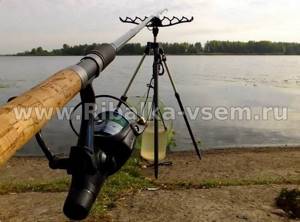
It is very useful to use feeders with a plastic body. They float up quickly and don’t stick to the bottom as much as metal ones. The best option is basket feeders with a wide flat weight.
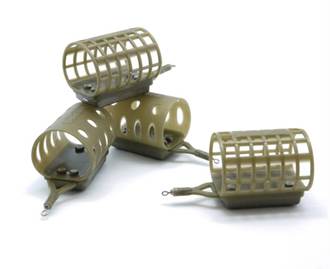
The stronger the current, the more closed the feeder should be. Mesh models are used when fishing in medium and weak currents. The food is washed out of them faster. When fishing in windy weather, you can also use bullet feeders with a plastic body. If the bottom is hard, then the bullets will not sink into it and the food will remain on the surface.
When fishing at close range, you can use rigid fishing lines with a minimum elongation of 0.25 mm in diameter or braids with a cross-section of 0.12 mm. We install reels with a spool capacity of 3000 to 4000 with a rear or front drag.
Any installation can be used. Only an anti-twist tube should not be used, as it can cling to the edge when unwinding the equipment. A method rig with a short leash and a foam bait on the hook works well when fishing on the edge.
The length of the leash is selected depending on the strength of the current. Most often, at the beginning they put a leash 50 cm long, and then they look at the situation. When fishing on the edge, it is better to use a leash made of tensile fishing line with a thickness of 0.14-0.18 mm. Be sure to have a feedergam or rubber thread for weaving with a thickness of 0.6-0.8 mm.
Such a reel usually holds from 10 to 20 meters and costs an order of magnitude cheaper than feeders sold in fishing stores.
Sometimes a piece of elastic 6 cm long saves the whole fishing trip. Often fishermen simply give up when another bream, crucian carp or ide leaves the hook when pulling it through the edge. It is only possible to pull out roaches and small breams. Large fish literally rest against the edge, and the leader often breaks. And if there is also a shell at the bottom, then this aggravates the situation. The rubber thread stretches very well and even sharp jerks are confidently nipped in the bud.
The fisherman has room to maneuver. You can put a longer segment between the leash and the main line, from 6 to 8 cm. Here we look at the situation.
You can buy thread for beads at almost any haberdashery store or sewing and crafts store. Just remember that it's called "beading thread" when you tell the seller what you need.
By the way, it is quite possible that such a thread is also suitable for rubber bands. You just need to find one that stretches well. This thread can also be used as a braid holder on a bobbin. Typically, a rubber band is used for such purposes. However, the thread is thinner and does not wear out as quickly.
Search for an edge
Only the heroes of fairy tales, throwing a net directly from the shore into the blue sea, can catch the “Golden Fish”. In reality, fish are resourceful and cunning. The fisherman must carefully study the underwater terrain and find the very place where the bite will be. This requires a good boat, dexterity, courage and healthy perseverance.
Seasoned fishermen have developed several sure-fire ways to find the edge on the river.
Visually
The easiest way to search is visual. It does not require special skills, only keen vision and knowledge.
Through clear water, the bottom pattern can be seen without any auxiliary equipment.
The saturation of the color of the water surface helps to detect the edge. Deeper places, where the water layer is thicker, acquire a dark color; in shallow water the color of the water is lighter. The more sharply the bottom level changes, the more clearly the break is visible. It should be looked for where the color border passes.
Another identifying feature is reeds, the roots of which are located at a depth of 1.5-2 m. If the thickets are uniformly dense, the eye will immediately highlight unovergrown clearings. Obviously, there is an edge along the border of their growth. This method will not work if the reeds grow too sparsely.
There are other external signs by which experienced specialists find edges and holes. For example, they visually determine the boundary between fast and slow currents.
Probing the bottom
It happens that the water in the river is muddy, dark like a swamp, and peaty brown. Then one of the palpation methods will help.
Wiring
Wiring means gradually smoothing the bottom with a weight. This takes a lot of time, but allows you to fully familiarize yourself with the topography of the reservoir.
A drop-shaped weight is tied to the end of a strong fishing line - it clings less, and is thrown in the direction of interest. After waiting until the drop reaches the bottom point, carefully pull it back. The feeling in your hands determines which surface the weight is moving on. If the line shakes, the weight moves over rocks or shells. If it is wound tightly, the weight gets stuck so that you have to periodically lift the feeder, which means the edge has been found. You need to throw it many times. Each cast will show something new on the map of the underwater landscape and will add to the fisherman’s experience. In addition, there may be large stones under the water; an inexperienced person may be deceived.
Beginners are advised to try this method on land first. Find a suitable area and throw the fishing rod into a shallow ravine or over a gentle hill. This will help you clearly see what obstacles are preventing the weight from moving. It is worth remembering that moving objects in water is much easier than on land. The braided cord has good sensitivity.
Tapping
Tapping is used when the fishing area has been determined, all that remains is to find a convenient fishing point. Due to the uneven testing mode, this method is also called jig wiring. For it, they often use not a feeder, but a spinning rod.
Here again a drop weight is used. It is attached to a fishing line and thrown to a marked place. Having felt the bottom, reel in the fishing line 3-4 turns. They release the reel, wait for the load to drop, count the seconds. Then repeat the procedure several more times.
If the lowering time has not changed, then there is no change in depth. If the gaps increased evenly, the load was lowered into the recess. If, on the contrary, they decreased, a rise is hidden under the water. A sharp change in the recorded time shows the edge: a short drop refers to the top, a long drop to the bottom.
The location of the drop is marked, keeping the length of the fishing line the same as it was at the time of a successful cast.
Search for an edge
Well, it’s good when we have a large stretch of coast at our disposal. In conditions of strong pressure from fishermen, there is not much choice. As a rule, “good” places are not empty, or are even passed on like in a relay race. But even in such conditions, when a place for fishing is not chosen, if a person knows how to “probe” the bottom, then he will not fish blindly.
The easiest way to find interesting places is to slowly move the load along the bottom.
We take a weight (preferably the “drop” type), cast it, wait until it reaches the bottom and begin a slow reel. It’s even better to move the feeder to the side, listening to the movement of the load along the bottom, then reel in the cord, and again wire the feeder.
When using a braided cord, very good sensitivity is achieved, and all obstacles encountered at the bottom, such as an edge or the edge of a pit, are reached to the feeder. The wiring must be done smoothly, without jerking. When you hit the edge or edge of a hole, you feel considerable resistance, and when you pass through the shells, you feel shaking. Over time, you can subtly learn to recognize all these nuances, and it will become increasingly easier to identify an interesting place on the bottom.
You can watch the video on how to cast a rod incorrectly:
Once you have decided on a place for feeding, stop reeling and place the feeder on stands in a place convenient for you. Make the necessary tension and fix the elastic band in the clip. Now with a fixed range and seeing the direction of casting, you will be able to deliver bait to the same place. This method is very good for still water or weak currents.
Anyone who has been interested in catching predators with a spinning rod knows “jigging” or, as it is called, tapping the bottom . It can also be used to study the bottom topography to find an edge or hole.
We take the same load and begin to tap the bottom. We cast, wait for the load to fall, make three or four turns with the reel handle, wait for the load to fall again, and count the time of this interval (the time from stopping the reeling until the load falls). If this time is constant, then the depth is constant; if it increases, then the depth also increases, and vice versa.
So, walking along the bottom, by touch, we can identify these very edges, colonies of shells, holes, drifts..., in general, everything that our fish likes so much. Having found the “right” place, as in the previous version, we fix the braid and begin to feed. We force the start of bait. We fill the feeder with a crumbly mixture without filler, and make five casts without a hook. At the bottom, for example along the edge, a cloud of turbidity quickly forms. And after that we catch as usual.
The main thing is not to be lazy and approach the study of the bottom more carefully. The time spent will more than pay off. You will know where you are casting and what is happening at the bottom. Studying the bottom will help you find an edge or hole. And this is a common practice in modern fishing.
Feeding the selected zone
After detecting the first edge, start feeding is done. Let us once again focus on choosing the right area to which the bait will be delivered. It should be level, or slightly sloping, so that the feeding table can be covered, and so that the feeder lies well on the bottom.
The advantage of fishing on the first edge is the fact that complementary food can be delivered in different ways. Starter feeding is done using the classic method - using feeders, or balls are made and delivered with slingshots, or manually.
The composition of the bait directly depends on the object being fished, the strength of the current and the time of year. If we are targeting bream, then we add more peas, millet, pearl barley and other grains to the mixture. If the current is above average, then be sure to add sifted clay or soil. These components will make the bait more viscous and the bait particles will be slowly washed out.
The same applies to catching ide. This fish loves boiled peas and wheat. The easiest way to prepare cereal is in a large thermos. Within 14-15 hours, the cereals are steamed until soft. Whole peas are taken, and larger wheat. After steaming, the wheat should open easily with slight pressure.

This is exactly what ide needs. They catch it successfully in places with a current. Wheat and peas are quite large grains and always stand out at the bottom.
If the fish in the selected area is quite passive, then it is better to use two feeders. It’s easier to throw them over the first edge at a distance of 4-5 meters from each other. You will get two feeding tables.
Feeders can be thrown to different edges: near and far. This is also a good way to determine where the fish are and what fishing distance will be optimal.
How to find holes on the river
A hole in the river is a very catchy place - proven by practice. It is in it that the toothy mouth of a predator waits for its prey - your bait; peaceful fish also spend a lot of time in it, which may also be interested in your bait. Therefore, you just need to know how to find holes in the river. A hole in the river is a very catchy place - proven by practice. It is in it that the toothy mouth of a predator waits for its prey - your bait; peaceful fish also spend a lot of time in it, which may also be interested in your bait. Therefore, you simply need to know how to find holes on the river - we will tell you about this today. But let's start with a definition so that it is clear what to look for.
What is a pit
So, a hole is a clearly expressed deepening of the bottom of a reservoir, be it a river, lake, pond, and so on. In practice, there is at least one, but every water area has it. And almost any hole is a catchable place, since fish are attracted by changes in relief, in which they can hide, rest, or even spend the winter. Having found it and made a bait point there, you can count on good catch.
The pit consists of the following parts:
- foothills - starts 20-30 m before the area with maximum depth, the bites here are the same as everywhere else along the river;
- entrance (dump) - a place with a gradual decrease in relief, very loved by predators;
- the pit itself is an area of maximum depth with the usual frequency of bites (with the exception of bottom-dwelling fish, for example, catfish, which are best caught here);
- exit - a place with a gradual increase in relief, catchable, although not as much as the entrance;
- post-pit - lasts 40-50 m after the area with maximum depth; asps and pike often bite here.
The shape of the pit can be:
- longitudinal - in the form of an ellipse, the more elongated part of which is located parallel to the flow;
- rounded - if they have steep edges, they are called whirlpools.
One of the secrets of luck
Finding a “fishy” or catchable place is the dream of every fisherman . Underwater inhabitants are usually located in the depressions of the bottom or in places where it bends. This is where the places where silt accumulates and forms are located, which means this is where they can count on additional food. Thus, the search for holes and edges becomes one of the main conditions for Fortune’s smile.
The most accessible methods include the following:
- Carry out a visual inspection;
- Use an echo sounder (acceptable only when fishing from a boat);
- Make several passes along the bottom.
Of course, with one glance at a pond, lake or river, only real professionals can determine where fish accumulate. Generally accepted guidelines here include:
- Reeds;
- Toplyaki;
- Unusual behavior of the water surface.
Advances in electronics in the form of echo sounders will be useful, alas, only when fishing from a boat or motorboat.
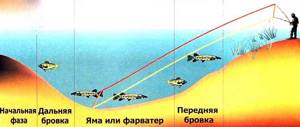
Finding a hole by examining the bottom
It’s easy to “feel the terrain” and find a deep area - just jig tapping the bottom.
- Hang a “drop” on the feeder rod and cast.
- Wait until the weight sinks to the bottom.
- Make 3-5 rotations of the reel handle and note how many seconds it takes for the “drop” to reach the bottom.
- Repeat the third step, constantly recording and checking the time.
With even terrain, the weight will fall to the bottom in the same number of seconds.
If, with steps, the time it takes for the “drops” to reach the bottom increases, you have reached the entrance (if you go with the flow) or the exit (if against) the hole. If the number of seconds is the maximum and it does not increase step by step, then you are going through the deepest part. All the time spent exploring the bottom will pay off with a good bite. By the way, in the same way - by jigging - you can find not only holes, but also edges on the river. Good luck in finding the most catchy spots - we want you to return home with a good catch.
Sources:
https://fishingday.org/kak-najti-brovku-ili-yamu/ https://oreke.ru/opredeleniya/brovka-reki https://feederist.ru/stati-i-rekomendacii/17-izuchaem-relef -dna https://zen.yandex.ru/media/id/5c5c95e5b5123200ad903fba/5d7479ec06cc4600acc0c766 https://fider.su/stati-i-rekomendatsii/kak-najti-yamy-na-reke
To search or not to search
Finding the edge is half the battle. But this does not provide a 100% guarantee of a good catch. Yes, the presence of an edge increases the chances of successful fishing, but other factors can also play a role here. After all, if all the fish were always in one place and biting well, the whole point of fishing would be lost.
But if the interest in a good catch is high, then you should work hard and find the edge. Ideally, you need to feed in this place so that the fish lingers in this area when searching for food. If the bite doesn’t start right away, you can wait. Prepare everything you need when the bite starts, get comfortable. In most cases, the fish always comes to the edge.
Subscribe to
our channel in Yandex Zen

